| Aug 13, 2019 | |
A new method for depositing manganese oxide thin-films on planar and complex nanostructured surfaces |
|
| (Nanowerk Spotlight) Manganese oxides have numerous applications in batteries, supercapacitors, microelectronics and (electro)catalysis – all of which can greatly benefit from conformally deposited MnO2 on high aspect ratio structures, e.g. 3D battery current collectors, or high surface area catalytic supports. | |
| New work published in Chemistry of Materials ("Redox Layer Deposition of Thin Films of MnO2 on Nanostructured Substrates from Aqueous Solutions") describes a cheap and fast method for depositing conformal thin films of MnO2 on nanostructured substrates with close-to-a-monolayer precision, competing with the state-of-the-art atomic layer deposition (ALD). | |
 |
|
| Redox layer deposition (RLD) cycle: monolayer adsorption of propargyl alcohol on a surface (left), reduction of MnO4- by the adsorbed propargyl alcohol and formation of thin MnO2 (right). The process requires only two beakers and a running water source for the washing between the sub-cycles. (Image: S. Zankowski, B. Kruszka) | |
| The development of our method was inspired by the first-grade high-school demonstration of a redox reaction, where aqueous potassium permanganate (KMnO4) is reduced by an alcohol (e.g. ethanol) at a neutral pH, forming solid MnO2 in the bulk of the solution. | |
| In our case, we limited the quantity of as-formed MnO2 to a monolayer by using aqueous propargyl alcohol – an unsaturated alcohol which can strongly chemisorb on various substrates, allowing reducing its amount to a monolayer for the subsequent reaction with KMnO4. | |
| Thus, our method consists of repeating cycles of surface-limited adsorption of propargyl alcohol and its subsequent oxidation with aqueous potassium permanganate, forming controllable amount of MnO2 on the substrate in each cycle. | |
| Because the amount of manganese oxide formed in each cycle is limited by the monolayer quantity of the adsorbed alcohol, the growth exhibits the self-limiting characteristics of atomic layer deposition. | |
| This state-of-the-art technique is based on a cyclic reaction of gaseous precursors on a surface, and typically ensures the highest conformality of the coating and sub-monolayer thickness control, at an expense of a very low deposition rate, need for elevated temperatures, expensive precursors and complex, thermally isolated gas-tight reactors. | |
| Contrary to the typical ALD, our new redox layer deposition (RLD) is performed in air, at room temperature, using common and cheap chemicals and simple glassware – literally, two beakers. This greatly reduces the costs and complexity of the deposition, making it accessible to virtually any laboratory or manufacturing plant. | |
 |
|
| SEM image of Ni nanomesh (left); EDX-STEM image of a fragment of Ni nanomesh coated with 3 nm MnO2 (right). The color mapping corresponds to Ni (yellow) and Mn (cyan). | |
| The method also shows at least 4?? higher growth-per-cycle and is at least 1.5?? faster than the known ALD process of MnO2 thanks to the high adsorption density of the alcohol molecules and MnO4- ions on the substrates. | |
| Specifically, we demonstrate application of the method for the fabrication of a nanostructured MnO2/Ni electrode using nanoporous interconnected Ni nanowires (nanomeshes) with thickness-to-pore-size ratio of ??55 and total surface area of 235 cm2 per sample. Conformal coating of MnO2 on such substrate was found not possible with ALD-MnO2 because of the parasitic decomposition of one of the ALD precursors on the high surface-area substrate – a known issue during the ALD of MnO2. | |
| On the other hand, RLD allowed for coating all the nanowires with a conformal layer of MnO2, with a close-to-expected thickness after the applied number of deposition cycles. Consequently, the nanostructured electrode fabricated with RLD was found to be significantly more active towards electrochemical insertion and extraction of Li+, as compared to the electrode prepared with ALD, which shows the potential of RLD for the 3D Li-ion battery applications. | |
| Our work is the first demonstration of an ALD-like growth of a metal oxide performed entirely in aqueous phase and open air. This is an important differentiator from the few previously reported liquid-phase ALD processes of some metal oxides (e.g. MnOx, TiO2 or MgO), which all utilized water-sensitive precursors dissolved in organic solvents and, thus, required anhydrous conditions and neutral gas environment of a glovebox or a Schlenk line. | |
| Although currently our RLD method is limited to substrates made of transition metals (e.g. Ni, Ti, Pt) and their oxides (e.g. TiO2), we believe that the range of compatible substrates can be increased in the future to e.g. Al2O3 or SiO2, by choosing appropriate organic adsorbates. | |
| Also, the RLD method could be tested for depositing other oxides than MnO2, by using different metal complexes that form insoluble products during redox reaction. Overall, thanks to its simplicity, the conformal deposition of MnO2 can be easily upscaled and thus exploited for its numerous (electro)chemical applications. | |
|
Provided by KU Leuven and imec as a Nanowerk exclusive
|
|
|
Become a Spotlight guest author! Join our large and growing group of guest contributors. Have you just published a scientific paper or have other exciting developments to share with the nanotechnology community? Here is how to publish on nanowerk.com. |
|
